These comics are usually (but not always) sequels to the original legend and often revolve around Arthur's promised return. As modern or future incarnations of the characters, the heroes of these stories are often heavily disguised. Stories which center on an Arthurian object or concept (e.g. the Holy Grail, Excalibur, etc.) rather than a personage, but which are not part of an ongoing series, have also been included in this category.
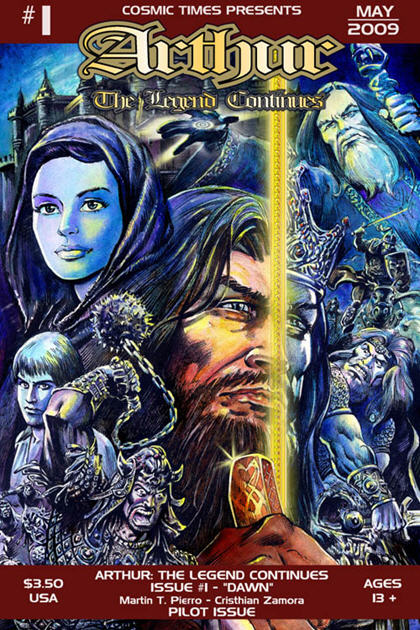 Written by Martin T. Pierro, illustrated by Cristhain Zamora. Cosmic Times, 2009-2010.
Written by Martin T. Pierro, illustrated by Cristhain Zamora. Cosmic Times, 2009-2010.
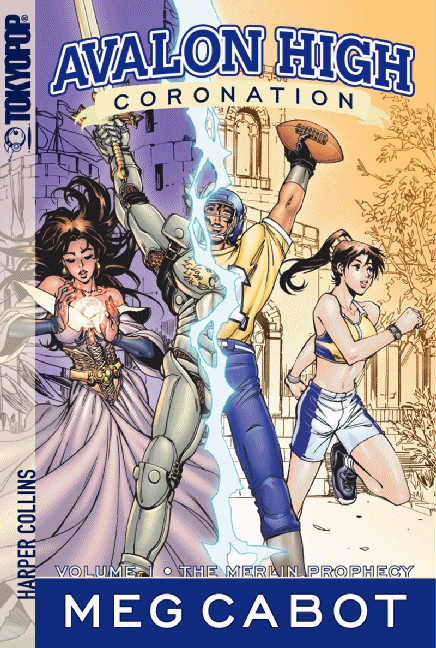
![]() Written and illustrated by David Miller. 4 issues, David Miller Productions, 2010. Collected in trade paperback as Dave Cockrum's Futurians: Avatar, 2011.
Written and illustrated by David Miller. 4 issues, David Miller Productions, 2010. Collected in trade paperback as Dave Cockrum's Futurians: Avatar, 2011.
The character of Avatar was created by Dave Cockrum and made his debut in a 1983 Marvel Comics graphic novel, The Futurians, written and illustrated by Cockrum. In that story, as well as in subsequent installments by Cockrum, Avatar is a member of a team of present-day heroes given super-powers by a future society called the Terminus. Identified as already being immortal before being granted the powers of flight and super-strength, Avatar goes by the name of Andrew Pendragon, suggesting an Arthurian association. This association was not made explicit, however, until several years after Avatar's creator's death in 2006, when David Miller revived the character for a four-issue miniseries. Here it is revealed that Avatar had at one time been the sorcerer Merlin. A flashback explains how Merlin earned Morgana La Fay's enmity by spurning her in favor of the Lady of the Lake; like Merlin, Morgana survives through the centuries, and resurfaces in the present day to make mischief for Avatar.
 Written
by Joe Pruett, illustrated by Goran Sudzuka and Richard Case. Image
Comics and Desperado Publishing, 2005-2006.
Written
by Joe Pruett, illustrated by Goran Sudzuka and Richard Case. Image
Comics and Desperado Publishing, 2005-2006.
This series centers on Megan, the daughter of King Arthur, and the first person to ever be born on the enchanted island of Avalon. After a long stay in Avalon, Arthur becomes restless, and suddenly one day departs into the mist, "a gateway to other worlds...worlds of fairies and goblins, lands of vanishing cities and places where lesser creatures walk as man." Megan, who is counseled by wise old Joseph (presumably Joseph of Arimathea) as well as Morgan (presumably Morgan Le Fay), ultimately decides to leave Avalon in search of her father and adventure. Only three issues have been published to date. A trade paperback collection was released in 2008.
Written by Kurato Osaki, illustrated by Edd Ashe. American Comics Group, 1965. Reprinted in black and white in Swords of Valor # 1 (A+ Comics, 1990).
In this 12-page story, a young knight named Dorian attempts to rescue a young lady-in-waiting named Hilda from the unwanted amorous attentions of a much older magician, Merlin, but only succeeds when he invokes the aid of magical pterosaurs from the prehistoric past. (Charlton publication information from the Grand Comics Database.)
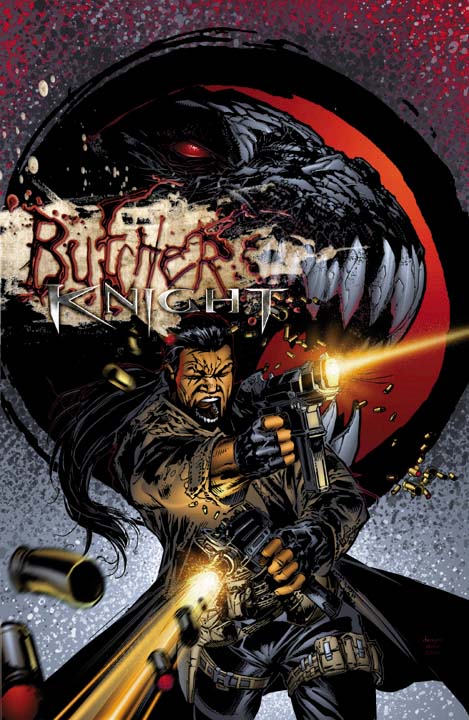 Written by Charles Holland, illustrated by Dwayne Turner.
Image
Comics, 2000-2001.
Written by Charles Holland, illustrated by Dwayne Turner.
Image
Comics, 2000-2001.
This story of Lancelot du Lac in contemporary times begins in Dark Crossings, published by Image in 2000. This two-issue miniseries, featuring the Image characters Witchblade, the Darkness, and Tomb Raider (from the well-known video game), tells how Lancelot (portrayed here as a black man) was betrayed by Merlin after the passing of Arthur. Attempting to gain the power to rescue Guinevere from the Queen of Bones, Lancelot allowed Merlin to transform him into a living gargoyle. After Guinevere had been saved, Merlin took vengeance on Lancelot for his and Guinevere's role in the fall of Camelot by imprisoning Lancelot in the stone body of the gargoyle, which was set on the roof of the convent where Guinevere would live out the rest of her life.
In the Butcher Knight series, Lancelot has returned to life in the present as Luther Washington, a reclusive painter who is still half-gargoyle, and who must consume the blood of demons to survive. Merlin still lives as well, as Barnabus London, head of a modern business empire. Luther finds himself allied with Daria, a seductive and ruthless witch seeking Merlin's power for her own purposes. The series concluded (somewhat abruptly) with the fourth issue.
Written by Budd Lewis, illustrated by E. R. Cruz. Black and white. Warren Publishing, 1980-81.
Borrowing a conceit introduced by T. H. White in his novel The Once And Future King -- that Merlin lives backwards in time -- Lewis and Cruz tell the story of Ambrose, an inept young stage magician who, in 1980, encounters the aged wizard Merlin -- his own "future" self, who has been sleeping for fifteen centuries under the enchantment of the witch Vivien. In the course of two published installments, Ambrose becomes a masked hero named Cagim and joins with King Arthur and twelve of his knights (revived as Rex Arthur and the Round Table Agency) to battle Vivien and her henchman Mordred to save the world. (Lewis also wrote an earlier, equally short-lived series about Merlin for Eerie.)
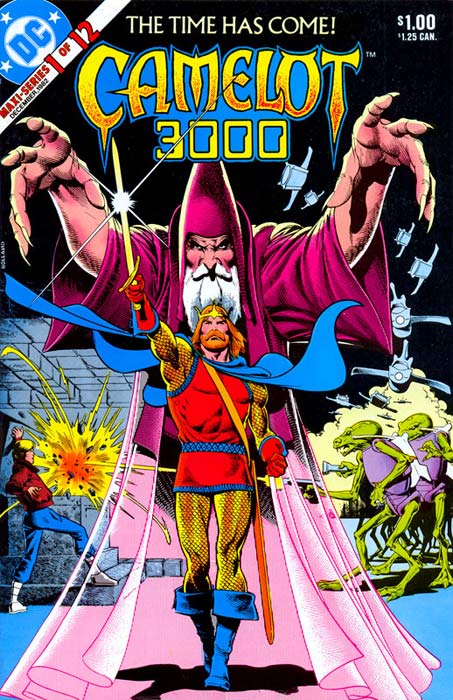
Written by Mike Barr, illustrated by Brian Bolland. 12 issues. DC Comics, 1982-1985. Reprinted in a single paperback volume in 1988, and in hardcover in 2008.
In Camelot 3000, perhaps the best known of Arthurian comic book series, Barr and Bolland tell of Arthur's return in the year 3000. As earth is invaded by aliens from outer space, Arthur is awkened from a centuries-long sleep in Glastonbury, Merlin is freed from Nyneve's spell holding him prisoner at Stonehenge, and eight knights, along with Guinevere, are discovered to have been renicarnated in this time. Lancelot is a wealthy French businessman and Guinevere is the commander of Earth's armed forces, while the other knights have returned in a variety of untraditional forms -- Gawain is African, Galahad is Japanese, and Tristan is a woman. The restored Knights of the Round Table soon learn that their old adversary Morgan Le Fay has also survived the centuries and is, in fact, behind the alien invasion. Morgan allies herself with Mordred, who has been reincarnated as the United Nations' Security Director. Lancelot and Guinevere resume their illicit affair, Merlin is again betrayed to Nyneve, and Perceval searches for the Grail, as the old story plays itself out once more.
Mike Barr came to Camelot 3000 as a veteran American scripter of superhero comics; Brian Bolland, as a popular British illustrator who had made his reputation as one of the early artists on the dark-humored dystopic science-fiction action series Judge Dredd. Their collaboration effectively combines their individual sensibilities with an understanding of the Arthurian mythos as much influenced by T. H. White (as refracted through Lerner and Loewe's musical Camelot) as by Sir Thomas Malory. The result is an imaginative extension of the Arthurian legend which, though it does not explore the legend's themes in an especially insightful way, is nevertheless an enjoyable science-fantasy adventure.
Also on the web:
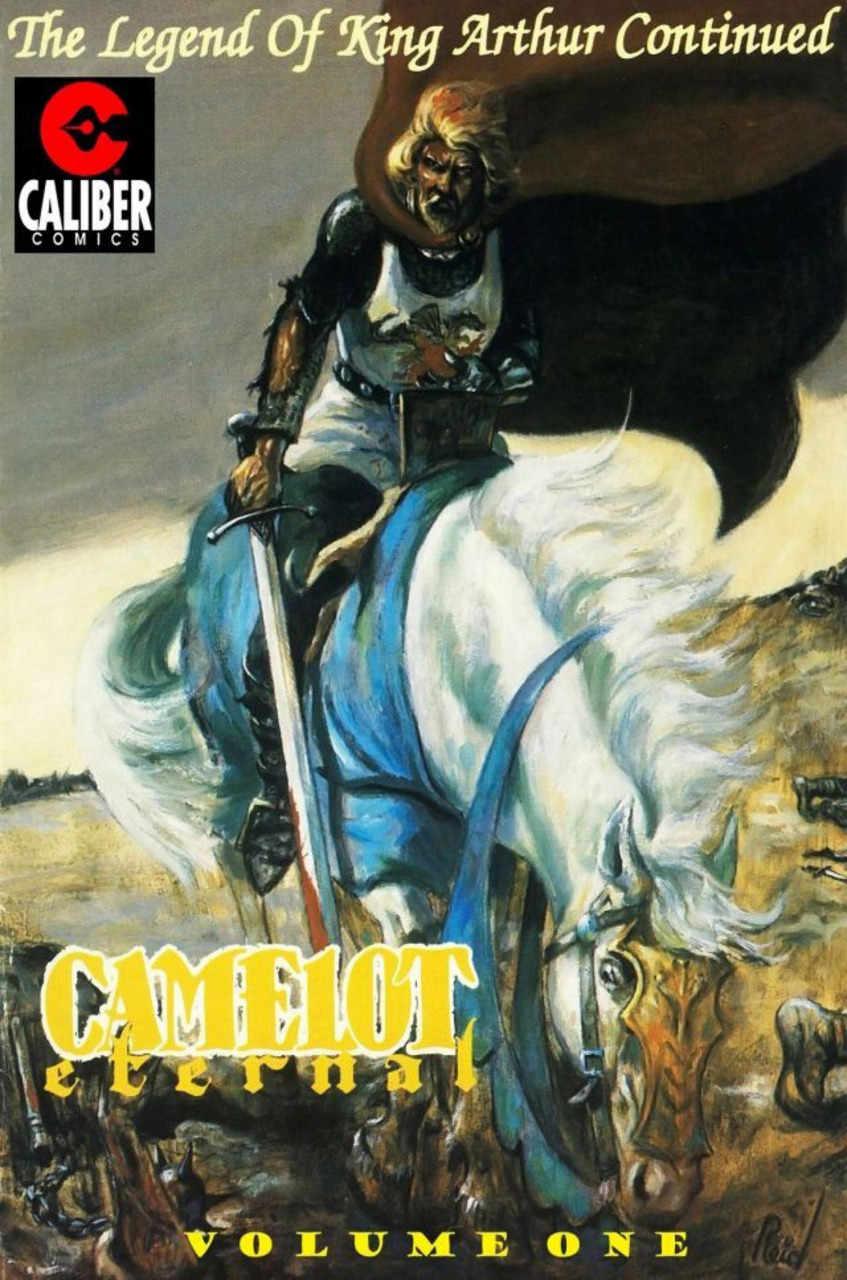
Written and illustrated by J. Caliafore. 8 issues, black & white, Caliber Press, 1990-1991.
This is an unusual series based on the question, "what if King Arthur hadn't died in his final battle with Mordred?" Since Mordred also survives, not to mention Lancelot and Gwynevere, the situation reverts fairly quickly to the basic state of things in Malory's last books (before the Queen is accused of treason). The series ceased publication before the story was completed.
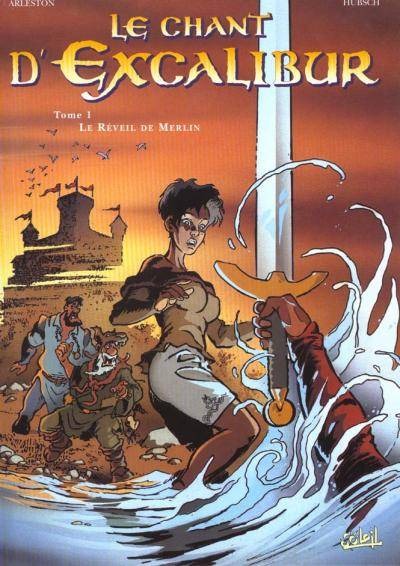 French.
Published in Dutch as Excalibur.
French.
Published in Dutch as Excalibur.
Written by Arleston, illustrated by Hubsch. Soleil Production, 1998-2010.
The six published volumes of this series include: La
Reveil de Merlin (in English, The Rise of Merlin);
Le
Sidhe aux Mille Charmes (The Sidhe of the 1000 Charms); La Griffe de Rome (The Griffon of Rome);
La Colere de Merlin (The Wrath of Merlin), Ys la Magnifique (Ys the
Magnificent); and Les Gardiennes de Broceliande (The Guardians of
Broceliande).
Robert
Vermaat
writes: "As a French comic, this series
has some
very clear Breton overtones, though the story is set in Ireland,
shortly after the year 1000." Merlin, who has slept imprisoned in
a dolmen for five hundred years, returns to a world where magic is
dying. The ascent of Christianity has led to the diminishing of
such beings as elves, fairies, and dragons, and Merlin's own power is a
shadow of what it was. Viviane, the Lady of the Lake, charges
Merlin to find the descendent of Sir Galahad, whom she will arm with
Arthur's sword Excalibur; together, Merlin and the hero can defeat the
tyranny of the Church and restore the old ways. Merlin
(characterized as a short, fat old man who loves food and drink)
agrees, though reluctantly, and is soon confounded by the discovery
that Viviane's chosen hero is a young woman -- Gwynned, a brave and
capable fighter with an independent spirit and a hot temper. At
the time she is offered Excalibur, Gwynned has just managed to excape
being married off by her father, and she is more than happy to take up
the quest. Gwynned and Merlin soon set off on a series of
colorful and humor-laced adventures.
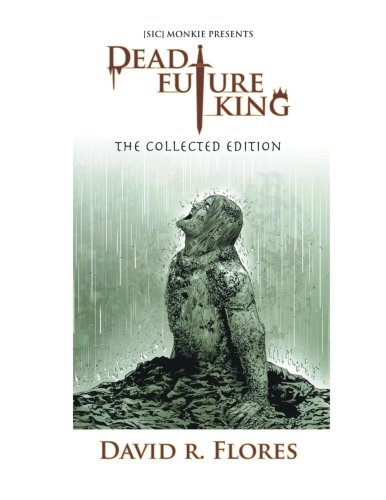 Written
and illustrated by David R. Flores. Alterna Comics (digital
publication), 2012 to date. Trade paperback collection of the
first three issues published by AuthorHouse.
Written
and illustrated by David R. Flores. Alterna Comics (digital
publication), 2012 to date. Trade paperback collection of the
first three issues published by AuthorHouse.Also on the web:
Official "Dead Future King" site
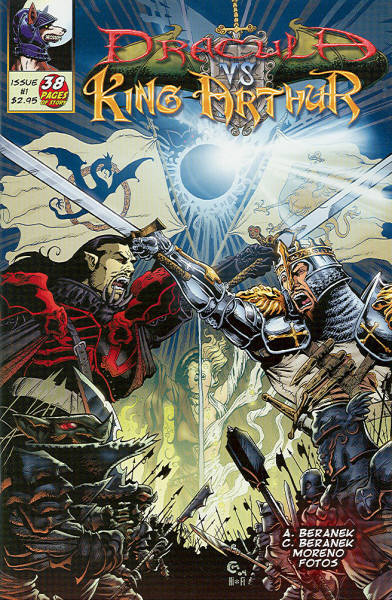
Written by Adam Beranek and Christian Beranek, illustrated by Chris Moreno. 4 issues. Silent Devil Productions, 2005. Reprinted in trade paperback and limited edition hardcover, 2007.
In this "high concept" miniseries, the 15th century Wallachian monarch known as Vlad the Impaler is turned into a vampire by Lucifer, and then transported 1000 years into the past to attack and destroy King Arthur and his court at Camelot.
Despite a frankly outrageous premise, the creators clearly know and respect their Arthurian source material, and they play their story straight. Appearing at first to be a previously untold tale of Arthur and his knights, the narrative gradually develops into a particularly dark version of the familiar tale of the final days of Camelot.
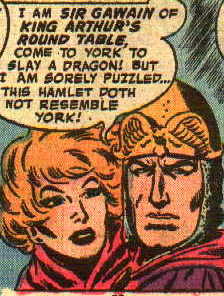
Written by unknown, illustrated by Bob Brown. DC Comics, 1958.
This short science-fantasy story from a DC Comics anthology
series, originally published in the May,1958 issue of the
long-running DC anthology series (and reprinted in issue #228,
Dec.-Jan., 1974-1975), describes an adventure of Sir Gawain in modern
New York City. An electrical storm causes a time warp which brings
not only the Round Table champion to Manhattan, but a fire-breathing
dragon as well. (Original publication information from the Grand
Comics Database.)
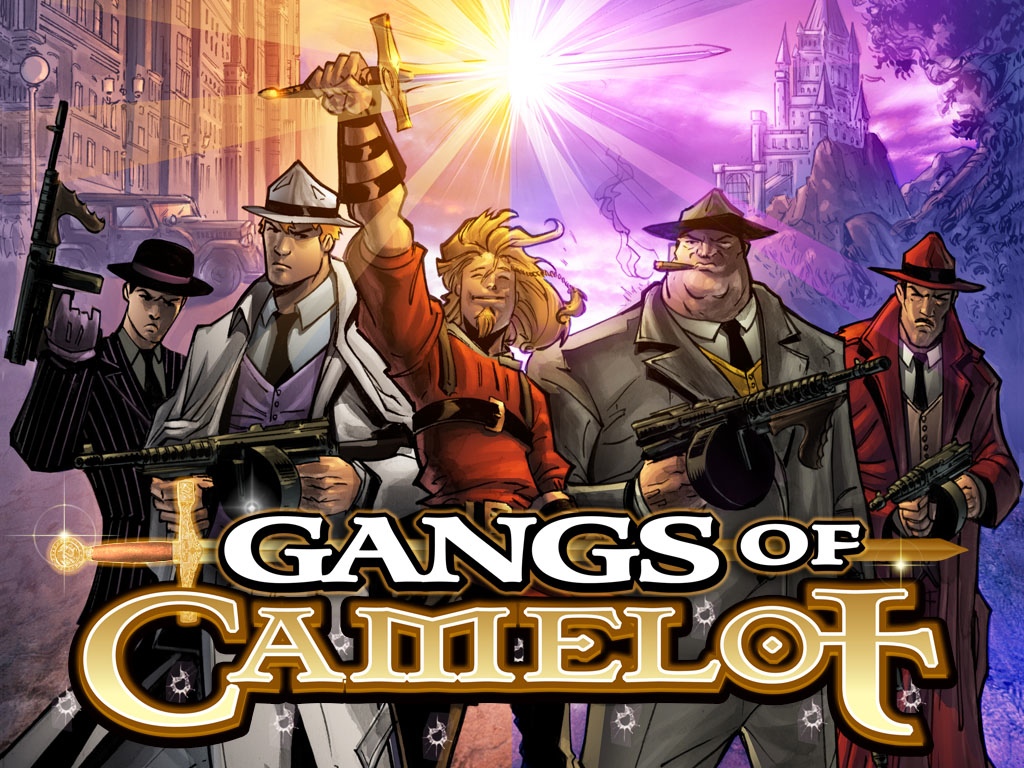 Written
by James Heffron. Illustrated by James Heffron and Vicente
Cifuentes. Lawdog Comics, 2006 (limited edition only), 2015
(general release).
Written
by James Heffron. Illustrated by James Heffron and Vicente
Cifuentes. Lawdog Comics, 2006 (limited edition only), 2015
(general release).
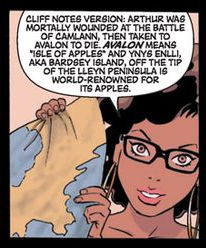 Written
by Andrew Cosby and Caleb Monroe. Illustrated by Matt
Cossin. 4 issues, BOOM! Studios, 2009-2010; collected in trade
paperback, 2010.
Written
by Andrew Cosby and Caleb Monroe. Illustrated by Matt
Cossin. 4 issues, BOOM! Studios, 2009-2010; collected in trade
paperback, 2010.
Written by J. M. DeMatteis. Illustrated by John Ridgway. Marvel Comics, 1988.
This 12-page story of an unnamed knight traveling through a desolate, plague-ridden land in search of the Holy Grail appeared in a one-shot anthology title from Marvel. The artist, John Ridgway, later illustrated Marvel's 1994-1995 Prince Valiant miniseries.
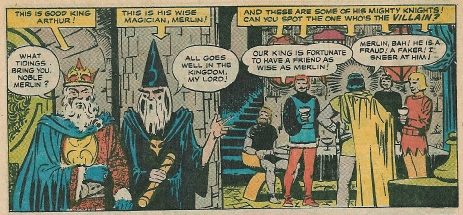 Written
by Stan Lee. Illustrated by Steve Ditko. Marvel Comics, 1963.
Written
by Stan Lee. Illustrated by Steve Ditko. Marvel Comics, 1963.
Merlin teaches a lesson to an arrogant knight in this 5-page story from one of Marvel's anthology titles. (Story reprinted in Marvel Super-Heroes v.1, #30, April, 1971. Original publication information from the Grand Comics Database.)
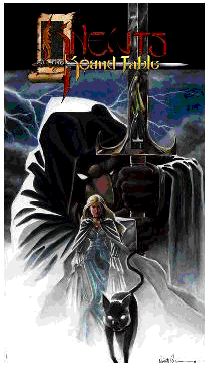
Written by Brian Fitzgerald, illustrated by Nirut Chamsuwan. 5 issues, Pan Entertainment, 1998-1999.
The following summary is from the creator's web site (www.knewts.com, inaccessible as of 2/24/00):
"It was a dark time for New Camelot...The Knights of the Round Table have been defeated and captured, but this news never reached King Arthur. Red Hand, a banished knight, led his Orcish horde to capture the kingdom which had no champions to defend it.
"In a cave far from the city, Lancelot, Galahad, Pervical, and G'wain awoke from a long slumber to a waking nightmare. Using a bewitched book, Red Hand had cursed the knights to a form part man, part newt. The shock of this transformation proved too much for G'wain, who raced into the forest mad and bewildered. He left behind a tentative Lancelot, a detached Percival, and a Galahad who believes that they have always been 'knewts'..."
Its punning title notwithstanding, the tone of this series is that of a dramatic fantasy adventure with occasional humorous touches.
Written by Dan Abnett and John Tomlinson, illustrated by
various
artists. 18 issues (1st series), 15 issues (2nd series), Marvel UK,
1990 -1993. One-shot published by Marvel Comics, 2014.
The Knights of Pendragon , in its original
incarnation, is
one of the most intriguing and original Arthurian comics series that
has yet appeared. The series is set squarely in Marvel Comics'
fictional universe and features superheroes such as Captain
Britain and Union
Jack
among the lead characters, as well as such guest stars as Iron
Man , the Black Panther,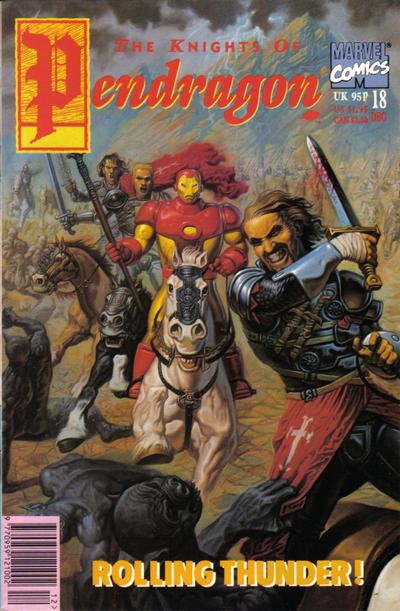 and
members of the Fantastic
Four. The premise of the series is based on an interpretation
of
the medieval English poem "Sir Gawain and the Green Knight" as an
ecological fable; the Green Knight is a personification of the
Earth's life force who bestows the "Pendragon force" on champions who
stand against the Bane, forces of "winter and warfare" who use
multinational corporations as well as black magic to achieve their
ends. The Pendragon champions (also referred to as the Knights of
Pendragon or simply the Pendragons) are a mix of ordinary British
mortals and professional heroes like Union Jack. Each Pendragon force
carries with it the memories of every champion it has possessed
through history, so at times the modern Pendragons are overwhelmed by
the personalities of prior champions like Gawain and Lancelot. The
15th issue of the first series introduces Adam Crown, a
and
members of the Fantastic
Four. The premise of the series is based on an interpretation
of
the medieval English poem "Sir Gawain and the Green Knight" as an
ecological fable; the Green Knight is a personification of the
Earth's life force who bestows the "Pendragon force" on champions who
stand against the Bane, forces of "winter and warfare" who use
multinational corporations as well as black magic to achieve their
ends. The Pendragon champions (also referred to as the Knights of
Pendragon or simply the Pendragons) are a mix of ordinary British
mortals and professional heroes like Union Jack. Each Pendragon force
carries with it the memories of every champion it has possessed
through history, so at times the modern Pendragons are overwhelmed by
the personalities of prior champions like Gawain and Lancelot. The
15th issue of the first series introduces Adam Crown, a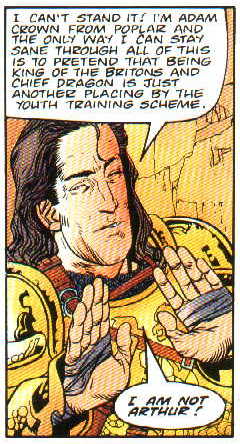 seventeen-year-old car wash attendant who, at the least, is possessed
by the Pendragon spirit of King Arthur, and may actually be the
"Chief Dragon" reincarnated.
seventeen-year-old car wash attendant who, at the least, is possessed
by the Pendragon spirit of King Arthur, and may actually be the
"Chief Dragon" reincarnated.
The first series features a unique blending of real-world envirionmental horrors, Arthurian fantasy, and superhero adventure, building to a truly memorable epic climax as Pendragon champions are called from every time and nation to defend the Green Knight in his stronghold, the Green Chapel in the mystical dimension of Avalon, against an overpowering assault by the forces of the Bane. The second series, written by the same authors but featuring different artists, is much less successful, with the concepts and characters reworked in an apparent attempt to make Knights of Pendragon a more conventional (and commercial) superhero team comic book on the model of Marvel's X-Men or Image's WildC.A.T.S., with mediocre results.
The title was briefly revived by for a one-shot in 2014 as part of a
crossover event, "Revolutionary War", that revived many of the
British-based superheroic charaacters published by Marvel UK in the
'90's. Unfortnately, the creators appeared to have little
sympathy for the sensibilities of the original series run, taking an
almost-parodic approach that included a "Zombie King Arthur" and his
"Zombie Knights of the Round Table", resulting in a product
unlikely to satisfy admirers of the original series.
See the entries for the Black Knight and Doctor Strange for other approaches taken to "the Pendragon" in Marvel's comics.
Co-author Dan Abnett also scripted the graphic novel Uther, the Half-Dead King.
Also on the web:
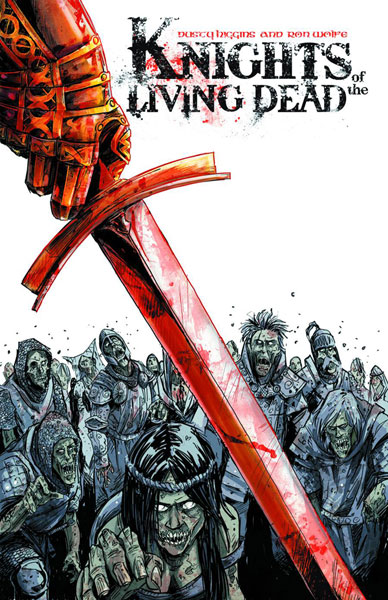 Written by Ron Wolfe, illustrated by Dustin Higgins. SLG Publishing, 2012.
Written by Ron Wolfe, illustrated by Dustin Higgins. SLG Publishing, 2012.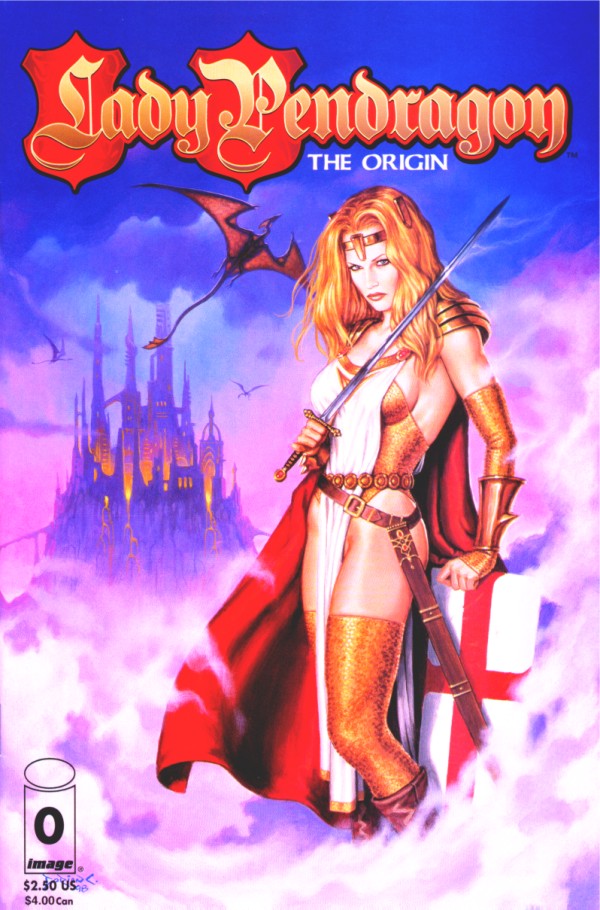
Written by Matt Hawkins, illustrated by various. First series, one issue, Maximum Press, 1996. Three-issue miniseries, Image Comics, 1998-1999. Ongoing series, 10 issues, Image Comics, 1999-2000. Various special issues, including Lady Pendragon: Prelude, Lady Pendragon v. 2 #0, Lady Pendragon/More Than Mortal, Lady Pendragon: Merlin, etc.
Matt Hawkins' Lady Pendragon, following an inauspicious start, became one of the most visible, and certainly the most heavily marketed, Arthurian comics of the 1990's.
The first and only Maximum Press issue begins with Arthur's death in battle with Mordred and describes how Queen Guinevere takes up the sword Excalibur and attempts to keep her husband's dream alive. In the Image Comics relaunch, Hawkins continues the story of Guinevere in the 6th century, but also introduces a present-day storyline centering on Jennifer Drake, a historical novelist who becomes the new Lady Pendragon when she pulls the magical sword Caliburn (in this version, a sister sword to Excalibur) from a stone and ushers in a new age of magic on Earth. Later issues feature parallel storylines of Guinevere and Jennifer Drake, though the latter comes to predominate. Jennifer is aided by Merlin in the present as she battles against modern incarnations of Morgana and Mordred.
During the series' run, Hawkins enjoyed incorporating a wide variety of material into his storyline, including a number of historical or scientific theories that many would call "fringe". Such material included, but was not limited to: Atlantis; the Ark of the Covenant; intelligent life on Mars; the "Christ's bloodline" theory of the Holy Grail; the Knights Templar; the "Spear of Destiny"; the Druids; and Greek, Babylonian, and Egyptian mythology. While it was hard to take the end results too seriously, a reader might have found that Hawkins' enthusiasm and audacity covered a multitude of sins. Hawkins moved on to administrative duties at one of Image Comics' partner studios in 2000, and suspended work on the series. He returned to his creation for a single issue, Pilot Season: Lady Pendragon, in 2008.
Caliber Press, 1999-2000.
This series of "one-shots" by different authors and illustrators generally featured retellings of traditional Arthurian legends, as described in Part One, but Legends of Camelot: The Enchanted Lady presented a previously untold story of young Arthur prior to his becoming king. The story provides a "secret origin" for a familiar Arthurian character.
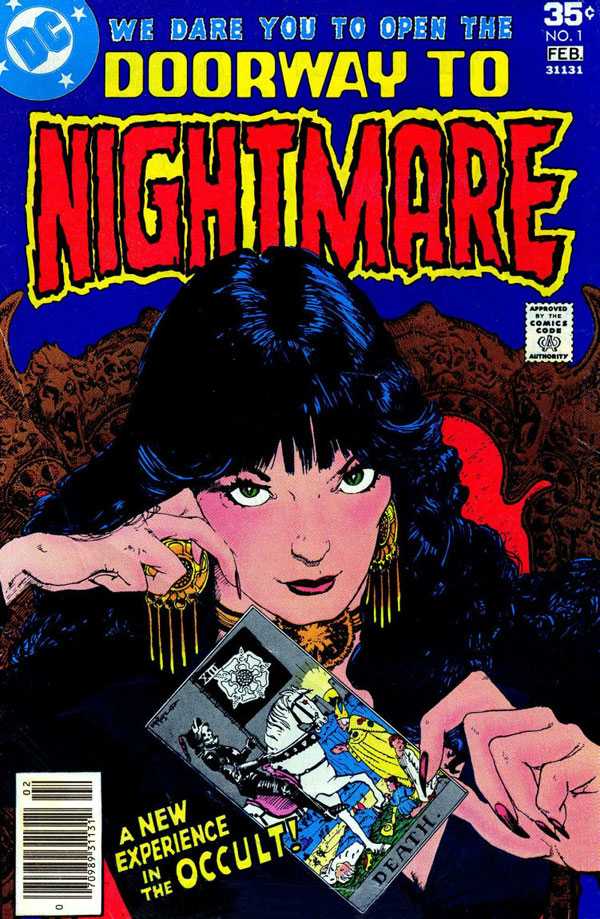
Written and illustrated by various, DC Comics, 1978 to date.
Madame Xanadu represents an unusual treatment of a traditional Arthurian figure in comics, having made her first appearance some thirty years before her identification as the sorceress Nimue was made explicit.
Created by David Michelinie (writer) and Val Mayerik (artist),
Madame Xanadu made her debut in Doorway to Nightmare
#1 (1978). Depicted as a mysterious woman operating a
fortune-telling parlour in contemporary Greenwich Village, Madame
Xanadu offered assistance to people facing various supernatural
threats. This series lasted only five issues, and after a
single follow-up one-shot (Madame
Xanadu v.1, #1, 1981), the character was relegated to
making guest appearances or playing a supporting role in a number of DC
Comics' series and miniseries. In The Spectre
v.3, #7 (1993), a story written by John Ostrander featured Madame
Xanadu explaining her past: "I used to be a sorceress. A
master wizard taught me my craft... He told me when we met
that it was fated and that in the end, I would confine him in a tree.
I did, too. It was his doom." The
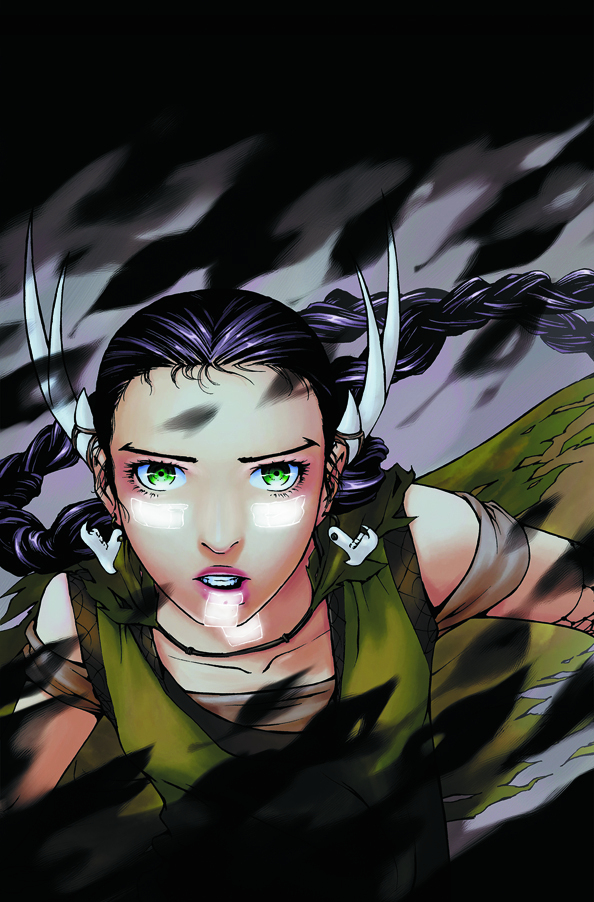 reference to the legend of
Merlin and Nimue was evident to the
knowledgeable reader, but the identification of Madame Xanadu with the
Arthurian character would not be made definite for another fifteen
years.
reference to the legend of
Merlin and Nimue was evident to the
knowledgeable reader, but the identification of Madame Xanadu with the
Arthurian character would not be made definite for another fifteen
years.
In the ongoing series Madame Xanadu
(published under DC's Vertigo imprint), author Matt Wagner (also the
creator of other notable Arthurian comics, as discussed in the Mage entry, below, and the Demon
entry
in Part Three)
and various illustrators chronicle the character's previously
untold history. The first two issues (Aug. - Sept., 2008)
described how the forest-dwelling enchantress Nimue Inwudu, sister to
both Vivienne (the Lady of the Lake) and Morgana, attempted to protect
Camelot from Morgana through her sexual influence over the wizard
Merlin. Nimue discovered, too late, that Merlin himself was
consorting with demons, and scheming to manipulate the course of
history. Unable to prevent the fall of Camelot, Nimue tricked
Merlin and imprisoned him in a hawthorne bramble, but not before he
"disenchanted" her with a final curse, forcing her to secure her
immortality thenceforth through the use of potions. (This sequence was reprinted in the trade paperback Madame Xanadu, Vol. 1: Disenchanted,
2009.) Subsequent issues depicted Nimue's adventures down through
the centuries, including sojourns in medieval China and Inquisition-era
Spain. An eight-part storyline beginning in the 16th issue
featured the return of Morgana in the year 1957, in New York City; an
extended flashback that appeared in the middle of this sequence filled
in more of the history of Nimue and her sisters, explaining how their
race of "Homo Magi" emigrated from Atlantis to Britain before the
advent of other humans in the latter island. Nimue and the others
of her kind witnessed centuries of human history in Britain before
Morgana, seeking to manipulate events, took on the human guise of a
daughter of Duke Gorlois of Cornwall, thus helping set into motion the
events leading to the rise and fall of Camelot. (The entire
storyline was reprinted as Madame Xanadu, Vol. 3: Broken House of Cards, 2011.)
Following the cancellation of her series with the 29th issue, a
somewhat-modified version of Madame Xanadu was introduced into DC
Comics' rebooted "New 52" continuity in two ongoing series, Justice League Dark (set in contemporary times) and Demon Knights.
The latter series, set in the Middle Ages four centuries after the fall
of Camelot, made Xanadu part of a medieval super-group of sorts, whose
other members included Etrigan the Demon and Sir Ystin, the Shining Knight.
This version of the character was depicted as being one of nine
sisters, all daughters of Lady Igraine of the Fey, who was Arthur's
mother as well. In the time of Camelot, Nimue had been
romantically involved with Merlin's assistant Jason, rather than Merlin
himself, and through the course of the series' 23-issue run, Madame
Xanadu was the lover of both Jason and his demonic alter ego, Etrigan,
with each of them believing her affection for his counterpart was
feigned.
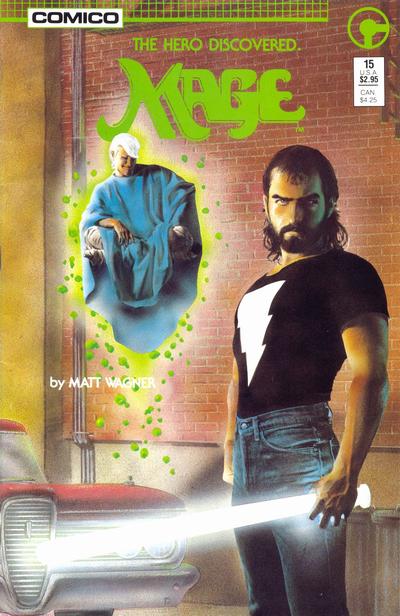 Written
and illustrated by Matt Wagner. First series, Mage: The Hero
Discovered: 15 issues. Comico, 1984-1986. Issues 1 - ?
reprinted
by Comico in a trade paperback volume (198?); all issues reprinted in
paperback
volumes by Donning (1988?) and by Image (1998 - 1999). "Interlude"
episodes of "Mage" published as back-up stories in Grendel
#
16-19, 1988. Second series, Mage: The Hero Defined:
15 issues. Image, 1998 - 2000; collected paperback
editions also published by Image.
Written
and illustrated by Matt Wagner. First series, Mage: The Hero
Discovered: 15 issues. Comico, 1984-1986. Issues 1 - ?
reprinted
by Comico in a trade paperback volume (198?); all issues reprinted in
paperback
volumes by Donning (1988?) and by Image (1998 - 1999). "Interlude"
episodes of "Mage" published as back-up stories in Grendel
#
16-19, 1988. Second series, Mage: The Hero Defined:
15 issues. Image, 1998 - 2000; collected paperback
editions also published by Image.
In the contemporary urban fantasy Mage: The Hero Discovered, a young man named Kevin Matchstick reluctantly gets involved with a magician named Mirth and an assortment of supernatural enemies under the command of the Umbra Sprite. Kevin finds himself possessed of superhuman abilities he doesn't want, and ultimately learns he's King Arthur reborn.
This first "Mage" series (the first of a projected trilogy) makes a subtle use of Arthurian themes throughout the story -- the Umbra Sprite is searching for the Fisher King, and his underlings include the Marhault ogre. Mirth's identification with Merlin is clear, if unspoken. The climax of the story comes with Kevin's drawing a magical baseball bat -- Excalibur -- from the side of an alley dumpster.
Arthurian elements are less overt in the second series, Mage: The Hero Defined, which finds the Pendragon joined by a number of other heroic archetypes, including incarnations of Hiawatha and Hercules. Mirth is nowhere to be found, and Kevin rejects the claim of an addled elderly man named Wally Ut to the title of "World-Mage". Kevin's heroic companions might be viewed as his Knights of the Round Table, or they might not. In the series' conclusion, the World-Mage is revealed, and Kevin learns that his identity as the Pendragon is more complex than he had supposed. The story of Kevin Matchstick is scheduled to conclude in a final series, Mage: The Hero Denied.
Both series present a unique and personal interpretation of the Arthurian legend, melding myth and folklore with aspects of the superhero genre as well as autobiographical elements (Kevin Matchstick is based, visually at least, on Matt Wagner himself), in an original vision which has resulted in one of the most intriguing and entertaining comics on an Arthurian theme produced to date.
Matt Wagner has also written and drawn a Demon miniseries featuring a very different approach to the legend of Merlin, and has also dealt with Arthurian elements in his writing for the Madame Xanadu series (see above).
Also on the Web:
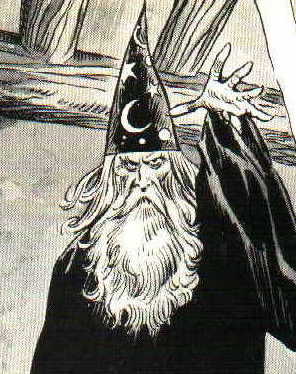
Written by Doug Moench, illustrated by John Buscema (penciller) and Tom Palmer (inker). Black and white, Marvel, 1980.
Long-time Conan the Barbarian artist Buscema attempted an artistic tribute to "Prince Valiant" 's Hal Foster in this single-issue story, an original adventure of Merlin set in the traditonal medieval Arthurian setting. A knightly young stranger charms the court of Camelot but turns out to be a son of the Devil; Merlin and Arthur have to rescue Guinevere from his nether realm. (More than two decades earlier, Buscema had illustrated an adventure of Sir Lancelot for Dell Publishing.)
Written by R. A. Jones, illustrated by Rob Davis. 2 issues, black and white, Adventure Comics, 1992.
Daniel Nastali provides this annotation to this sequel to the same creators' Merlin: "Merlin here agrees to assist the sorceress Rhiannon as she travels with her mysterious lover Tryon to a magical place where his identity will be revealed. Defeating Pictish warriors led by a Druid lord, Merlin learns that Rhiannon's partner is a messenger of the Celtic god Lug."
E.C. Comics, 1955.
For many of today's comics fans, E.C.'s horror, science
fiction,
and crime anthology comics represent a high point in 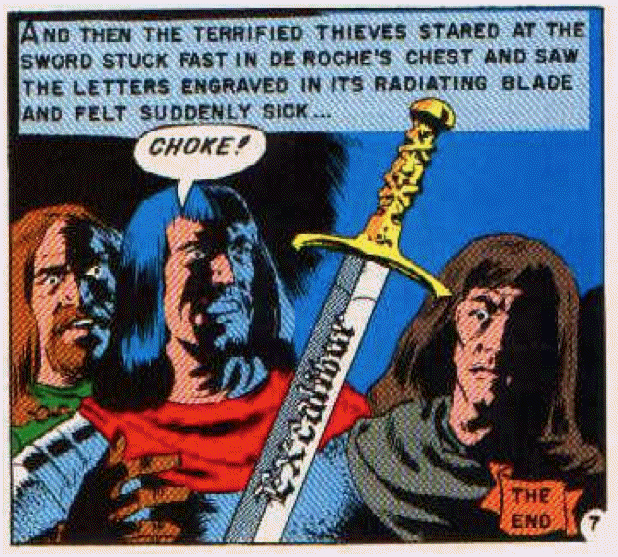 the
history of the comic book; in the 1950's, however, these same comics
attracted so much negative attention that the publisher, threatened
with censorship, eventually felt compelled to cancel them, replacing
them with a variety of new comics. One of these, Valor,
featured short stories dealing with heroism and combat in historical
periods ranging from ancient Rome to the time of Napoleon.
the
history of the comic book; in the 1950's, however, these same comics
attracted so much negative attention that the publisher, threatened
with censorship, eventually felt compelled to cancel them, replacing
them with a variety of new comics. One of these, Valor,
featured short stories dealing with heroism and combat in historical
periods ranging from ancient Rome to the time of Napoleon.
During its short five-issue run, Valor featured two original stories including Arthurian characters, both written by Al Feldstein and drawn by Wally Wood. In "The Return of King Arthur", Arthur appears to have returned from Avalon during the time of the Crusades to lead a revolt against Norman tyranny -- but is he truly what he seems? In "The King's Service", a young knight is challenged to prove his loyalty to King Arthur and worthiness to join the fellowship of the Round Table -- but who is the mysterious old man who joins Sir Geoffrey's quest as the young knight's squire? Both of these stories feature twist endings in the E.C. tradition.
Both stories, along with the rest of the Valor series run, have been reprinted in recent years in both a single-volume hardcover (black and white) and as indivdual periodical issues (color) by Russ Cochran and Gemstone.
Written by ?, illustrated by Rafael Astarita and other(s).
Chesler, 1937 - 1938. Some episodes reprinted in Chesler's Star Comics vol. 2, #3 & 4 (1939), Cocomalt Big Book of Comics (1938), Carnival Comics #1 (1945), and Komik Pages #10 (1945).
Daniel Nastali provides this annotation: "King Arthur's court jester
brags about his heroic achievements in this series of 2 and 3-page
colored stories told in four lines of verse in each panel. There are
only a few Arthurian elements, and at least one episode--the
eleventh--was drawn by a lesser artist." Astarita also wrote and
illustrated the earlier "King Arthur" strip for DC's "New Comics", as discussed in Part One.
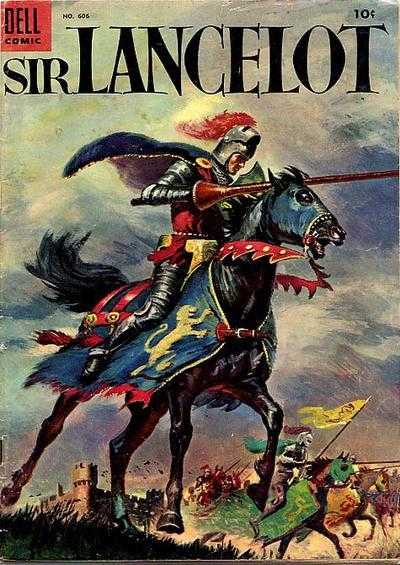
Dell Publishing Co., 1954.
Dell published one adventure of the most famous knight of the Round Table in its Four Color anthology series prior to the American premiere of the television series, The Adventures of Sir Lancelot. (A later Dell one-shot based on that series is discussed in Part Five.) I do not actually know if the 1954 issue featured a retelling of a traditional Arthurian story or a new adventure; although precedent appears to favor the former, I have decided that the more prudent choice is to list it here.
Written by ?, illustrated by ?. Charlton Comics, 1957. Reprinted in Charlton Classics #6 (1981) and in black and white in Swords of Valor # 1 (A+ Comics, 1990).
This 5-page adventure features Lancelot's rescue of a young woman and her father from a castle besieged by the wicked Duc de Fer. (Charlton publication information from the Arthurian Annals and the Grand Comics Database.)
Five other comics series may be mentioned in this category. All of these feature Arthurian characters in supporting, rather than central, roles, or as one figure in an ensemble:
Morgan Le Fey appears in the six-issue miniseries The Black Dragon (Marvel, 1985; reprinted in one trade paperback volume by Dark Horse Comics, 1996), written by Chris Claremont and illustrated by John Bolton. In this fantasy adventure set in England during the time of Eleanor of Aquitaine, Morgan is portrayed as the Queen of Faerie. Other Arthurian characters and themes are not mentioned.
A Distant Soil, written and illustrated by Colleen Doran, is essentially a science-fiction series about a group of contemporary Earthlings (a couple of whom are the children of an extraterrestial) who become involved in a conflict between factions on the planet Ovanan. Galahad is a supporting character in the storyline, presented as a knight of the otherworldly realm of Avalon who becomes involved with the other characters when he falls through an interdimensional gateway into our world. A Distant Soil has been published in three distinctly different versions since 1983; it is currently being published by Image Comics, with three trade paperback reprint collections available. (More information is available on the official A Distant Soil web site.)
Fate's Five features Merlin, Captain Nemo, Dracula, Frankenstein's Monster and the King of Atlantis, all brought to the present to battle evil. (Source: posting by Rodney Parrish to the alt.legend.king-arthur newsgroup..)
Knights on Broadway, a short-lived science-fiction series from Broadway Comics (1996), features a prescient child genius who is inspired to create a new band of high-tech knights to avert future catastrophe. She imagines that she may be the reincarnation of Morgan Le Fay; this question was left unresolved by the series' cancellation after three issues.
Otherworld (DC/Vertigo, 2005), a seven-issue miniseries written and drawn by Phil Jimenez, tells the story of a diverse group of young people from modern-day Los Angeles who are transported to an alternate world divided between opposing forces of magic and technology. Merlin appears as one of the main leaders on the side of magic.
StarGods (Antarctic, 1998 - ?; title spelled "Stargodz" on covers) is a science-fiction series focusing on galactic empires whose rulers are the basis for the gods of human mythologies. The series includes in its cast a priest named John Gilead who is identified as Sir Galahad, the "Grailknight". Story and art are by Dean Zachary and Scott Clark.
Weirdworld
is a Marvel Comics series spun off from the publisher's 2015 "Secret
Wars"crossover event. The version of Morgan Le Fey familar from
issues of Avengers, Spider-Woman,
and other superhero comics is featured as the queen of one realm among
others within an other-dimensional, magical land called Weirdworld.
Last updated 5/8/25. Email your comments and suggestions to Alan Stewart.